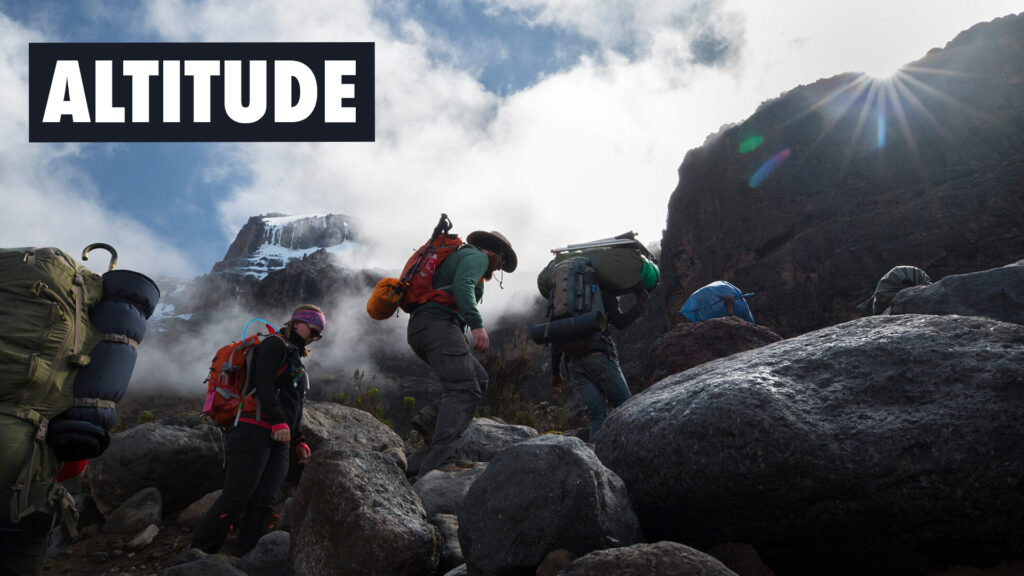
At 19,341 feet, the summit of Mount Kilimanjaro exposes climbers to issues not normally dealt with when trekking at lower altitudes. It’s important to understand not only how this affects your body, but how to prepare and ready yourself to mitigate whatever affects you do feel so as you can continue on with your climb and enjoy yourself on the roof of Africa!
The issues associated with altitude can cause a lot of concern to potential climbers as they prepare for this adventure! The best most effective way to combat these issues is to bring along with you the very best possible physical version of yourself! By following a training guide, having the proper clothing, gear, and equipment, addressing your nutritional needs, as well as staying rested and hydrated, you can greatly enhance your ability to negate the effects of altitude.
Twice daily while on your climb, your medically-trained mountain guide will sit down with you, discuss how you are feeling and examine you so as to ensure that you are not suffering any adverse effects due to elevation as well as take any preventative measures necessary to negate future issues.
Why is hiking at altitude different than hiking at sea level? Air is made up of nitrogen, oxygen, and argon with traces of other stuff in it. Nitrogen is about 78%, oxygen is 21%, and argon is 1% – those percentages stay constant no matter what the elevation. Air pressure becomes less as you climb up a mountain and less air pressure means you have less oxygen to breathe. High altitude hiking is when you trek at an elevation that may negatively affect your body; some people are affected as low as 7,000 feet.
Let’s take a minute to explain a bit about air pressure and available oxygen. If you put your arms out and turn around, you’ve made a circle that is about 5 feet wide. Imagine that circle being a column of air going from the ground up to the edge of the atmosphere. From where you’re standing, there are thousands and thousands of feet of air above you in your column. All the nitrogen, oxygen, and argon above you is pushing down on the air around you. The height of that column of air determines the air pressure where you are and that air pressure determines how densely the gas particles are packed together. The higher you climb, the less air there is above you in the column, so the lower the air pressure and the less dense the gas will be.
For every 1,000 feet you climb, you lose about 3% of the available oxygen because there is less gas packed into your column of air. At 12,000 feet, every breath you take brings in only 2/3 the amount of oxygen that you would breathe in at sea level. Another important thing to keep in mind is that air temperature drops about 3.5 degrees for every 1,000 feet of elevation gain. A nice 75 degree day at 5,000 feet will be more like 60 degrees at 10,000 feet. As you climb ever higher, you need to understand the added risks and problems with higher altitudes. You will find yourself needing to breathe deeper and more often just to keep enough oxygen circulating to your muscles. Every breath has less oxygen, so you need more breaths.
Everyone needs to breathe more when they are hiking at altitude. But some people become sick when they hike too high. It just happens.
The biggest problem with hikers is that they want to reach their goal and may not accept that they need to stop when problems occur. Being honest enough to stop and possibly turn back can be a very difficult step to take, so communication here is the key. Guides are highly trained to assist you, so the moment you are feeling any new or uncomfortable signs, please seek out your guide and heed their advice.
There are many factors that come into play when altitude sickness hits, but taking some simple steps will help minimize your risk.
Acclimatize!
The biggest contributor to altitude sickness is climbing too fast. That means the person in good shape has a good chance of getting sick since they tend to push harder and hike faster. People that reside at lower elevations will experience a greater change at lower heights. Your trek had been designed to acclimatize you slowly and steadily. Check how you are feeling every hour. Nausea, lack of hunger or thirst, headache, dizziness, difficulty breathing and lack of coordination can all be warning signs. On your multi-day hike, you will never sleep at a higher elevation than you have climbed. Climb high, sleep low will be a big part of your adventure!
Expect It
Just because you went to 14,000 feet last summer does not mean your hike to 12,000 feet will not affect you next weekend. Any height over 8,000 feet should make you be on the alert. Every hike is a new experience and by being on the lookout for symptoms, you will catch problems early on.
Hydrate, Eat Well and Reduce Exertion
Drinking more water helps reduce the symptoms. Drink even if you do not feel thirsty. Also, the harder you push your body, the greater your risk of getting symptoms. Eating a high carbohydrate menu will give you the energy needed to push throught.
Despite your best efforts and preparation, Acute Mountain Sickness (AMS) can still happen. About 75% of people who trek over 10,000 feet will experience some type of mild AMS symptoms. Hikers can usually continue on with these mild symptoms, but if they do not subside or they get worse, then corrective action is required. The problem with AMS is that its symptoms are similar to other common hiking problems such as dehydration, fatigue, and eating bad food. Ignoring these symptoms can result in extreme situations, possibly death. Ordered from most severe to least:
- Disorientation – Confusion, hallucinations, irrational behavior can all be caused by edema, which is swelling of tissue and can be caused by higher elevation.
- Loss of Coordination – Someone stumbling or dropping their water bottle should be a signal. If you suspect someone may be experiencing this, test them – have them walk heel-to-toe in a straight line and stand straight with feet together and arms at sides and then close their eyes. They should be able to balance for at least 15 seconds.
- Lassitude – Similar to exhaustion; just being tired out. There will be no energy to eat, talk, or do anything as the situation worsens. After eating and drinking water and resting, exhaustion should go away. If it does not get better, consult your guide immediately.
- Headache – There are many causes for a headache, from bright sun to altitude sickness. If a headache doesn’t go away after aspirin, food, water, and rest, then you might suspect altitude sickness.
- Nausea – Upset stomach and loss of appetite are yet another sign of AMS.
High Altitude Pulmonary Edema, (HAPE) although less common on Kilimanjaro, is something worth understanding. High Altitude Pulmonary Edema is excess fluid in the lungs which further reduces oxygen exchange from air to your body. The level of oxygen in your blood diminishes which can lead to impaired thinking and ultimately death. HAPE symptoms include shortness of breath while at rest, feeling of tightness in the chest, weakness, feeling of suffocating, persistent cough, and fatigue. The person may also cough up watery fluid. Twice daily on your climb, your guides will check the oxygen levels in your blood using a simple oximeter.
Even less common on Kilimanjaro is High Altitude Cerebral Edema (HACE). High Altitude Cerebral Edema is excess fluid in the brain which puts pressure on the brain. This usually develops over a few days but is a life-threatening situation. Disorientation and strange behavior soon leads to unconsciousness most likely followed by death if nothing is done.
Now that you understand some of the issues involved when hiking at altitude, what can you do to treat altitude related sickness? The most important thing to do is stay alert and address any early symptoms with your guide as soon as possible. The longer symptoms develop, the more drastic the response will need to be. Assuming you catch the symptoms early, together with your guide you will both follow these simple steps:
- Rest – Take a break and take in some fluids and food. Take aspirin for headaches. Do not be in a hurry and plan a break for an hour or so to give the symptoms a chance to recede.
- Medicate – Acetazolamide is the generic name for a prescription drug available under the brand name Diamox and is the most tried and tested drug for altitude sickness prevention and treatment. This drug does not mask symptoms but actually treats the problem. It seems to work by increasing the amount of alkali (bicarbonate) excreted in the urine, making the blood more acidic. Acidifying the blood drives ventilation, which is the cornerstone of acclimatization. Side effects of acetazolamide include: an uncomfortable tingling of the fingers, toes and face, carbonated drinks tasting flat; excessive urination; and rarely, blurring of vision. Many climbers use Diamox on the trek. If interested, it is recommended that you discuss this matter with your personal health care provider.
- Descending: If necessary your guide will have you descend at least 1,500 feet down the mountain and rest.
- Discontinue the trek: In rare cases, severe symptoms will require you to stop the hike and descend completely off the mountain.
During your climb your guides should be checking in with you often and monitoring these and other issues. In addition, you will be examined twice daily to ensure you are healthy, happy and able to continue. It is imperative that you discuss all your symptoms and concerns with your guides while on Kilimanjaro. While you cannot train for the effects of altitude you certainly can prepare for it.
Listen to our podcast about Altitude Sickness








